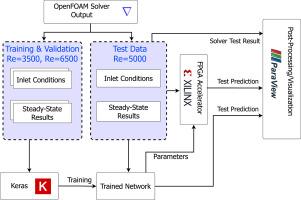用于 CFD 加速的优化神经网络的 FPGA 实现
IF 3
3区 计算机科学
Q2 ENGINEERING, ELECTRICAL & ELECTRONIC
Aeu-International Journal of Electronics and Communications
Pub Date : 2024-11-09
DOI:10.1016/j.aeue.2024.155574
引用次数: 0
摘要
在这项工作中,对 FPGA 作为特定领域人工智能加速 CFD 模拟的核心计算平台进行了评估。评估分为三类:能效、速度和精度。研究中的特定领域是 FDA 喷嘴基准,使用 SimpleFoam 进行模拟,这是一种层流求解器,是 OpenFOAM CFD 工具箱的一个组件。所提出的人工智能模型是一个具有三个全连接层的低参数前馈神经网络,使用不同雷诺数的稳态解进行训练,所有雷诺数均由 OpenFOAM 框架计算。根据求解器生成的初始迭代次数,所提出的模型可以生成稳态 CFD 仿真结果。此外,本文还介绍了使用 SoC 芯片推理模拟结果的硬件实现方法,硬件资源利用率极低。建议的硬件设计是针对 Zynq-7000 片上系统从零开始开发的,仅使用 VHDL,无需依赖第三方商业人工智能框架或为人工智能相关应用设计的昂贵 FPGA 板。与常规 CFD 工作流程相比,测试案例研究中提出的工作流程在保持相对较高精度的同时,仿真时间减少了 98%,能耗降低了 95.6%。本文章由计算机程序翻译,如有差异,请以英文原文为准。

FPGA implementation of an optimized neural network for CFD acceleration
In this work, an evaluation of FPGAs as the central computation platform in domain-specific AI-accelerated CFD simulations is performed. This evaluation is performed in three categories: power efficiency, speed, and accuracy. The specific domain in the study is the FDA nozzle benchmark, which is simulated using SimpleFoam, a laminar solver that is a component of the OpenFOAM CFD toolbox. The proposed AI model is a low-parameter feed-forward neural network with three fully connected layers, trained using steady-state solutions distinguished by various Reynolds numbers, all of which are computed by the OpenFOAM framework. The proposed model can then generate the steady-state CFD simulation result given the initial few iterations generated by the solver. Moreover, this paper introduces a hardware implementation for inference of the simulation results using an SoC chip with minimal hardware resource utilization. The suggested hardware design is developed from scratch for Zynq-7000 System-on-Chip, using only VHDL, and requiring no dependencies on third-party commercial AI frameworks or costly FPGA boards designed for AI-related applications. The proposed workflow in the test case study achieves a 98% reduction in simulation time while maintaining relatively high accuracy and a 95.6% reduction in energy consumption compared with the regular CFD workflow.
求助全文
通过发布文献求助,成功后即可免费获取论文全文。
去求助
来源期刊
CiteScore
6.90
自引率
18.80%
发文量
292
审稿时长
4.9 months
期刊介绍:
AEÜ is an international scientific journal which publishes both original works and invited tutorials. The journal''s scope covers all aspects of theory and design of circuits, systems and devices for electronics, signal processing, and communication, including:
signal and system theory, digital signal processing
network theory and circuit design
information theory, communication theory and techniques, modulation, source and channel coding
switching theory and techniques, communication protocols
optical communications
microwave theory and techniques, radar, sonar
antennas, wave propagation
AEÜ publishes full papers and letters with very short turn around time but a high standard review process. Review cycles are typically finished within twelve weeks by application of modern electronic communication facilities.

 求助内容:
求助内容: 应助结果提醒方式:
应助结果提醒方式:


